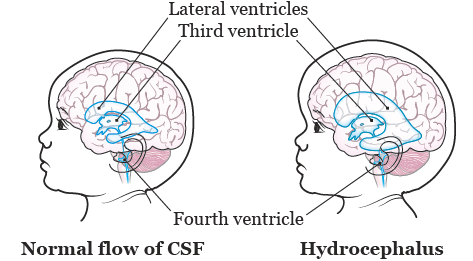This information explains hydrocephalus (HY-droh-SEH-fuh-lus), including what it is and how it’s treated. In this resource, the words “you” and “your” refer to you or your child.
What is hydrocephalus?
Hydrocephalus is the buildup of extra cerebrospinal fluid (CSF) in the ventricles (hollow spaces) in your brain. This makes your ventricles bigger and puts pressure on your brain (see Figure 1).

CSF is a liquid that’s made in the ventricles in your brain. Your CSF protects your brain and spinal cord by acting like a cushion. It also brings nutrients throughout your brain and carries waste away. You’re making new CSF all the time.
Normally, CSF flows from your ventricles, around your brain and spinal cord, and into your bloodstream. Hydrocephalus can happen if the flow of CSF is blocked or if not enough CSF is absorbed into your bloodstream.
What causes hydrocephalus?
Some people are born with hydrocephalus. You can also develop hydrocephalus if you have:
- Bleeding in your brain
- Meningitis (swelling in the thin layers of tissue covering your brain and spinal cord)
- A head injury
- A tumor in your brain
- Cysts (small sacs of tissue, often filled with fluid or pus) in your brain
What are the symptoms of hydrocephalus?
The symptoms of hydrocephalus are different depending on your age and which disease stage you’re in. The most common symptoms of hydrocephalus include:
- Increased head size and bulging soft spot in infants
- A headache that doesn’t get better after resting or taking medication
- Vomiting (throwing up) with little or no nausea (feeling like you’re going to throw up)
- Fatigue (feeling unusually tired or weak)
- Irritability (becoming easily frustrated or annoyed)
- Personality changes (not acting like your normal self)
- Problems with thinking and memory (such as confusion)
- Trouble with balance or walking
- Trouble waking up or staying awake
- Weak bladder control
- Seizures
- High pitched cry in infants
- Trouble eating
- Problems seeing, such as:
- Blurred vision
- Double vision
- Vision loss
- Eyes that turn downward (also called sunsetting)
How is hydrocephalus diagnosed?
A physical exam is done to look for signs and symptoms of hydrocephalus. After that, your doctor will use imaging tests (such as a computed tomography (CT) scan or magnetic resonance imaging (MRI) scan), to take a closer look at your brain and confirm the diagnosis of hydrocephalus.
How is hydrocephalus treated?
Hydrocephalus is treated by taking the extra CSF out of your brain. This helps your remaining CSF flow normally again.
In most cases, a ventriculoperitoneal (VP) shunt is used to drain the extra CSF. A VP shunt is a device that’s placed in your body during a surgery. The shunt takes the CSF out of your brain and moves it into your abdomen (belly), where it’s absorbed by your body. This lowers the pressure and swelling in your brain. For more information, read the resource About Your Ventriculoperitoneal (VP) Shunt Surgery for Pediatric Patients (www.mskcc.org/pe/vp_shunt_surgery_peds).
Instead of a VP shunt, you may have a surgery called an endoscopic third ventriculostomy (ETV) to treat your hydrocephalus. During an ETV, a tiny hole is made in the third ventricle of your brain. This lets the extra CSF drain into another area of your brain where it can be absorbed. For more information, read the resource About Your Endoscopic Third Ventriculostomy (ETV) Surgery for Pediatric Patients (www.mskcc.org/pe/etv_surgery_peds).
As the VP shunt or ETV drains extra CSF and lowers the pressure in your brain, it may relieve your symptoms. Some symptoms will go away right after your surgery. Others will go away more slowly, sometimes over a few weeks.
When should I call my healthcare provider?
Call your healthcare provider right away if you’re having any symptoms of hydrocephalus.